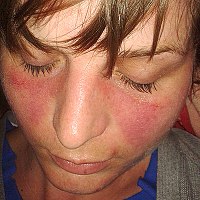
Photo from wikipedia
Propionibacterium acnes: (P. acnes) produce Porphyrins; however, fluorescence measurement of Porphyrins from Ultraviolet-A (UVA) images has failed to establish a correlation. Acne clinical research and imaging has ignored the spectral… Click to show full abstract
Propionibacterium acnes: (P. acnes) produce Porphyrins; however, fluorescence measurement of Porphyrins from Ultraviolet-A (UVA) images has failed to establish a correlation. Acne clinical research and imaging has ignored the spectral excitation-emission characteristics and the exact pattern of the Porphyrins synthesized by P. acnes. In this exploratory study, for the first time, the possible relationships of Coproporphyrin III (CpIII) and Protoporphyrin IX (PpIX) fluorescence as well as acne lesion-specific inflammation measurements with clinical signs of acne are investigated. Furthermore, the sensitivity of these measurements in tracking and differentiating the known treatment effects of Benzoyl Peroxide (BPO) 5%, and combination of Clindamycin + BPO are also evaluated. Comedonal and papulopustular lesions identified by investigators during a live assessment of 24 mild-to-severe acne subjects were compared with fluorescence and inflammation measurements obtained from analysis of VISIA®-CR images. CpIII fluorescence spots showed a strong correlation (r = 0.69–0.83), while PpIX fluorescence spots showed a weak correlation (r = 0.19–0.27) with the investigators’ comedonal lesion counts. A strong correlation was also observed between the investigators’ papulopustular lesion counts and acne lesion-specific inflammation (r = 0.76). Our results suggest that CpIII fluorescence and acne lesion-specific-inflammation measurement can provide objective indication of comedonal and papulopustular acne severity, respectively. Furthermore, these measurements may be more sensitive and specific in evaluating treatment effects and early signs of acne lesion progression compared to investigators’ lesion counts.
Journal Title: Archives of Dermatological Research
Year Published: 2017
Link to full text (if available)
Share on Social Media: Sign Up to like & get
recommendations!